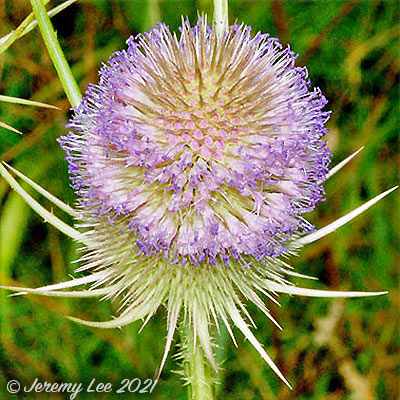
 |
|
Scientific Classifications explained » Amphibians » Ants » Aphids » Bees » Beetles » Birds » Bugs » Butterflies » Caterpillars » Damselflies » Dragonflies » Earwigs » Flies » Frog/Leafhoppers » Fungi » Galls » Grasshoppers » Harvestmen » Hoverflies » Lacewings » Ladybirds » Leaf Mines » Lichens » Mammals » Millipedes » Mosses » Moths » Sawflies » Slugs » Snails » Spiders » Trees & Shrubs » Wasps » Wild Flowers » Woodlice » PB |
UK Nature > Wild Flowers > Blue & Purple Wild Flowers > Dipsacus fullonum

Scientific Name: Dipsacus fullonum Common Name: Teasel Dipsacus fullonum, more commonly known as Teasel, is a robust, tall biennial which can grow to 1.8m or more. All parts of the plant have spines - leaves, stalks and egg shaped flower heads. The plant and seed heads persist into winter, providing a bit of structural interest in a wildlife area when other plants have died back. Teasels are common in rough grassland, wood margins, thickets and hedgerows, also on roadsides and waste ground over a very wide range of soil types. The pinkish purple or white flowers in mid- to late summer are popular sources of pollen and nectar for bees and other insects. Teasel fruits prolifically, its persistent seed heads attracting seed-feeding birds, particularly goldfinches. |
|

https://www.uknature.co.uk is a website dedicated to showing the immense diversity of UK nature and wildlife. Our vast range of habitats, from lowland arable to snow covered mountains, from storm-ravaged coastlines to peaceful inland freshwater lakes and rivers, from dry, sandy heaths to deciduous and coniferous forests, all these habitats contribute to the abundance of UK nature. We have wild birds in huge numbers either residing or visiting our shores (597 recorded species as at July 2013) and we must also not forget the humble back garden with its grass lawns, flower beds filled with nectar rich flowers, shrubs and trees, all designed to attract huge numbers of insects such as bees, moths, butterflies and hoverflies; and finally the small ponds which provide safe havens for frogs, toads, newts and even slow worms and grass snakes. www.uknature.co.uk is the showcase for my personal passion, photographing uknature in all its glory. I sincerely hope you all enjoy the fruits of my labours. This site and all images contained therein is © Jeremy Lee 2004 - 2025. All Rights Reserved. Site design by Jeremy Lee. Site development & IT Support by Stuart Lee. |